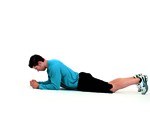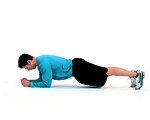Desk-bound employees can develop a hunched posture that saps energy and strength. Here’s a safe-for-the-office routine that can help.
For many people, nine-hour workdays are the minimum—and lunch breaks are short or taken at the desk. Even if the person goes to the gym a few times a week, it isn’t always enough to offset the impact of so much time at work.
This can lead to upper-crossed syndrome, the shoulders-hunched, head-jutting-forward position that signals muscle imbalances in the neck, chest, shoulders, and back. Fortunately, you have the tools to help—especially if you are a Corrective Exercise Specialist (CES).
“Developing a program that breaks someone away from his or her desk and gets them moving and active will result in a happier, healthier, more productive employee,” says Jonathan Penney, NASM-CPT, previous general manager for Plus One Health Management, a company that develops fitness solutions for companies across the United States.
The routine featured here—created by Penney and Rick Richey, MS, NASM-CPT, CES, PES, CSCS, LMT, owner of R2 Fitness in New York and an NASM Master Instructor—not only does that, it also fights those upper-crossed syndrome imbalances. And it’s easy for clients to take advantage of the moves in an office setting, during the workday.
Start Here
Before recommending this workout to anyone, Penney and Richey both say an overhead squat assessment to determine imbalances is smart. Once you’ve identified imbalances, you can then suggest a specific foam-roller routine to lead into the workout. The idea is to inhibit the overactive muscles before moving into any stretching or muscle activation movements.
All in Order
This workout is designed so that clients finish the “A” exercises in a circuit before moving on to the “B” exercise, the “C” exercise circuit, and so on.
Warm-Up - 2 to 4 minutes
Choose from a variety of mobility movements:
- Knee Hugs: Stand up straight. Raise one leg with knee bent. Gently pull knee toward the body; lower and repeat on other side.
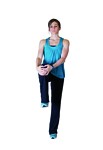
- Frankenstein Kicks: Stand up straight, arms out in front. Raise one leg at a time, keeping it straight, trying to touch the opposite hand.
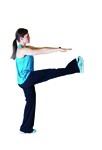
- Squat to Stand: Stand; lower to squat position. Stand back up.
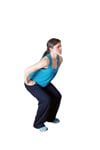
A Circuit
- Reach, Roll, and Lift - 2 to 3 sets, 6 reps per side each
- Wall Angel- 2 to 3 sets, 10 reps each
- Lean the back flat against a wall with knees slightly bent, keeping head pushed back against the wall. Move both arms out to side with elbows bent at 90 degrees. Both elbows and both wrists should be touching the wall.

- Slowly slide both arms up the wall, keeping the elbows and wrists touching the wall, trying not to let the back arch. Then slide back down. Repeat.

- Lean the back flat against a wall with knees slightly bent, keeping head pushed back against the wall. Move both arms out to side with elbows bent at 90 degrees. Both elbows and both wrists should be touching the wall.
B Exercise - YTA
2 to 3 sets, 10 reps each
- Stand with feet hip-width apart. Keep abdominals tight, and bend slightly at the waist.

- Lift arms in front and slightly to the sides of the body at a 45-degree angle, keeping thumbs up (palms facing each other) and pinching shoulder blades back and down (this is the Y position).
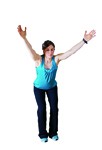
- Move arms straight out to the side, with thumbs still up (T).
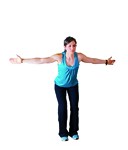
- Lower arms to sides of body with thumbs up, still retracting and depressing the shoulder blades. Return to the start position (A) and repeat. Aim to slowly move from one position to the next over a six-second count. To increase difficulty, lean your upper body forward a bit more.

C Circuit
- Floor Bridge- 2 to 3 sets, 10 reps each
- Lie on back with knees bent, placing feet flat on the floor, shoulder-width apart. Arms are at sides with palms up. Tighten abdominals and contract glutes.

- Slowly push through heels and lift pelvis off the floor until knees, hips, and shoulders form a straight line. Hold the top position for two seconds and then slowly lower pelvis back to the floor. Repeat.

- Lie on back with knees bent, placing feet flat on the floor, shoulder-width apart. Arms are at sides with palms up. Tighten abdominals and contract glutes.
- Plank- 2 to 3 sets
D Circuit
- Scaption Push-Up- 3 sets, 10 reps each
- Get into a push-up position (a more upright push-up against a desk is fine), feet together, abdominals tight, body straight, hands slightly more than shoulder-width apart.
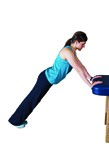
- Slowly lower, then press back up to the start.
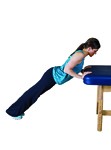
- At the starting position, raise right arm slightly in front (in line with shoulder blade), thumb up. Hold briefly, then lower back to push-up position. Do a push-up, then repeat with other arm.
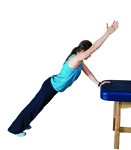
- Get into a push-up position (a more upright push-up against a desk is fine), feet together, abdominals tight, body straight, hands slightly more than shoulder-width apart.
- Quadruped Chin Tuck- 3 sets, 10 reps each
Quick Neck Saver
Trouble with neck strain while sitting at a desk? Make sure your client isn’t dropping her head to her chest or jutting her head forward to try to work it out. “That’s going to increase the compensatory patterns exponentially, unfortunately,” says Richey. Instead, he recommends tucking in that chin and pressing the back of the head into the back of the chair, so it’s in a kind of retracted position. This activation will help relieve the strain.
Conclusion: improve your health and posture
Hopefully you found these exercise ideas helpful. You can really improve the health of your clients if you jump at this opportunity to target your desk-bound clients.
If you are currently looking for great ideas to implement for your clients, be sure to check out our new guide to personal training during the COVID-19 pandemic.
Because more and more people are working from home and do not have access to the gym, now is as important as ever a time to introduce even more options for the fitness sucess of your clients!






